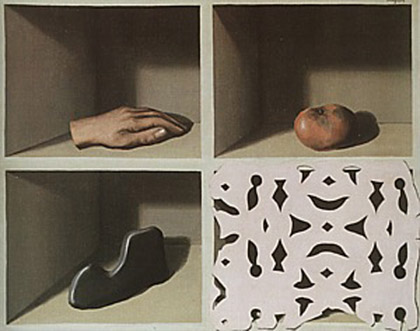
| HOME |
| NERVE |
| REVIEWS |
| ARCHIVE |
| EVENTS |
| LINKS |
| ABOUT US |
| CONTRIBUTORS |
| BACK ISSUES |
| CONTACT US |
Rene Magritte: The Pleasure Principle
 24th
June - 16th October 2011
24th
June - 16th October 2011
Tate Liverpool
Reviewed by Sandra Gibson
When you think about Rene Magritte (1898 – 1967) you inevitably smile at those bowlered men raining down on a townscape, or trains coming out of fireplaces or an apple taking up all the space. What was revolutionary in the generation of the Surrealists is now common territory. The challenging, mind-expanding novelty of the movement has become part of our visual acceptance through advertising, modern comedy, film and commercial art. To a certain extent, the legacy of Surrealism has been trivialised: not another burning giraffe…yawn.
Having so much of Magritte’s work exhibited: his paintings, home movies, commercial art and photographs, provides the opportunity to re-appraise his importance and access work rarely seen before.
What surprised me, in spite of my knee-jerk association of Magritte with blue skies, was the sombre palette, the cumulative claustrophobic effect of his work and a feeling of ambiguity and menace – Magritte was fascinated by pulp fiction – which puts us in Poirot territory. It’s all rather clothy and banal – curtains and suits and masks and rooms waiting for something to happen. His work has something of Chirico’s intense theatricality combined with the claustrophobic precision of Max Ernst’s Une Semaine de Bonte.
But there is more to it than these stage settings for the enactment of popular fiction or as disturbing dreams. Magritte was fascinated by a sense of mystery – something “vaguely magical” which could be evoked through art, going so far as to say that the world would not exist without this. For him it was the painter’s “superior powers” that allowed him access to the mystery. He became aware of the potency of objects and their position in a process of transformation, this metamorphosis having “no break between the two substances” and his paintings are imbued with a frisson of potential and surprise. A pair of boots metamorphoses into feet; or are the feet becoming boots? Who knows? “To be a Surrealist means barring from your mind all remembrance of what you have seen, and being always on the lookout for what has never been.”
Magritte was interested in the relationship between image, word and representation. “An object is never so closely attached to its name that another cannot be found which suits it better.” He loosened the connection between object and word by renaming them and he famously challenged the illusionist tradition in post-Renaissance art with his painting of a pipe entitled Ceci n’est pas une pipe.
One of Magritte’s most famous paintings, The Human Condition, depicts a scene through a curtained window in front of which is an easel with a painting of the view positioned in such a way that the objective landscape and the painting of it exactly overlap. Because of the visual clue - the side of the canvas - we presume that by moving the easel we would reveal the real scene and it would exactly match the painting. But this is an unverifiable presumption because the painting within the painting is forever locked in. As Robert Hughes states, “this sense of slippage between image and object is one of the sources of modernist disquiet.”
Most important, as far as I’m concerned, is Magritte’s preoccupation with the notion of reality. By playing around with scale and transformation and using the artist’s techniques to produce the illusion of real figures and objects Magritte does indeed challenge his audience to bar from their minds all remembrance of what they have seen. Are these men falling from the sky or are they fixed? We presume they are moving downwards because they are subject to gravitational pull. Are the smaller figures smaller because of distance or because they are small? The point is that we are reacting, by thinking like this, to something we think is part of our world and subject to conventional explanation. Our mind has to have its story straight but Magritte says that reality is unfathomable: “What does that mean? It does not mean anything, because mystery means nothing either, it is unknowable.” The painting of a mountain, apparently on glass, that has shattered into shards to reveal the ‘real’ mountain has us debating whether that mountain is the actual scene or whether its reality can also be shattered in some way and so on, to infinity in a quest for the ultimate reality.
And all this speculation while we know, in our rational mind, that ceci n’est pas une montagne, but shapes of pigment on a flat surface. We allow the conjurer to trick our senses not just because it is entertaining but because he confronts the big issues. And that is why Magritte is important: not because of his quirky images and dreamworld pictures, not because of his elegant fashion drawings and art deco posters and not because of his impact on popular culture. Magritte’s significance lies in his exposition of the human need to know what is real and the futility of these attempts to know it.
And the Surrealists were challenging conventional ways of seeing reality against a newsreel of truncated propaganda messages and jack-booted certainties. Brave people.